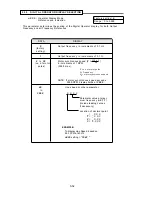
5-43
Continued
D.
PID Settings
n130: PID Proportional Gain
Factory setting: 1.00
Range: 0.00 to 10.00
Proportional gain is the value by which the error signal is multiplied to generate a new PID controller
output. A higher setting will result in a more responsive system. A lower setting will result in a more
stable system.
n131: PID Integral Time
Factory setting: 1.00
Range: 0.00 to 360.0 sec.
This parameter determines how fast the PID controller will seek to eliminate any steady-state error.
The lower the setting, the faster the error will be eliminated. To eliminate the integral function
entirely, set this parameter to 0.0 seconds. A lower setting will result in a more responsive system.
A higher setting will result in a more stable system.
n134: Integral Value Limit
(1)
Factory setting: 100.00
Range: 0.00 to 100.0%
This parameter will limit the effect that the integrator can have. It works whether the PID controller
output is positive or negative. It can also be used to prevent integrator "wind-up".
n132: Derivative Time
Factory setting: 0.00
Range: 0.00 to 10.0 sec.
This parameter can be adjusted to increase system response to fast load or reference changes, and
to reduce overshoot upon startup. To eliminate the differential function entirely, set this parameter to
0.00 seconds.
n163: PID Output Gain
(1)
Factory setting: 1.0
Range: 0.00 to 25.0
This parameter is a multiplier in the output of the PID controller. Increasing this parameter will make
the PID controller more responsive. Be careful not to increase this parameter too much or the
drive / system will become unstable.
n133: PID Offset Adjustment
(1)
Factory setting: 0.0
Range: -100.00 to 100.0%
This parameter will add a fixed percentage to the PID output. It can be used to tune out small
system offsets. NOTE: This parameter is set as a percentage of maximum output frequency (n011).
n135: PID Output Lag Filter Time
(1)
Factory setting: 0.00
Range: 0.00 to 10.00 sec.
This parameter adds a filter to the PID output to keep it from changing too quickly. The higher the
setting, the slower the PID output will change.
All of these parameters are interactive, and will need to be adjusted until the control loop is properly
tuned, i.e. stable with minimal steady-state error. A general procedure for tuning these parameters is
as follows:
1. Adjust Proportional Gain until continuous oscillations in the Controlled Variable are at a
minimum.
2. The addition of Integral Time will cause the steady-state error to approach zero. The time
should be adjusted so that this minimal error is attained as fast as possible, without making
the system oscillate.
3. If necessary, adjust derivative time to reduce overshoot during startup. The drive’s accel and
decel rate times can also be used for this purpose.
(1)
These parameters are factory set for optimum results for most applications, and generally
don’t need to be changed.
5.28 PID Control
Summary of Contents for GPD315/V7-4X
Page 1: ...GPD 315 V7 and V7 4X Technical Manual...
Page 4: ......
Page 20: ...xvi...
Page 22: ......
Page 40: ...1 18...
Page 52: ...3 2...
Page 56: ...4 4...
Page 101: ...5 45 PID Block Diagram...
Page 130: ...A1 8...
Page 134: ...A3 2...
Page 136: ...A4 2...
Page 146: ...A6 6...
Page 150: ...A7 4...
Page 154: ...A8 4...
Page 158: ......
Page 160: ......
















































